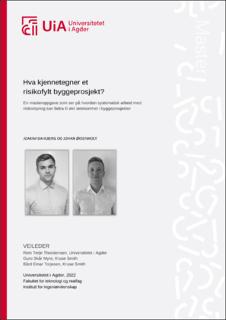| dc.contributor.advisor | Rein Terje Thorstensen, Universitetet i Agder | |
| dc.contributor.advisor | Guro Skår Myre, Kruse Smith | |
| dc.contributor.advisor | Bård Einar Torjesen, Kruse Smith | |
| dc.contributor.author | Dahlberg, Joakim | |
| dc.contributor.author | Øksenholt, Johan | |
| dc.date.accessioned | 2022-09-26T16:23:48Z | |
| dc.date.available | 2022-09-26T16:23:48Z | |
| dc.date.issued | 2022 | |
| dc.identifier | no.uia:inspera:106884570:9999353 | |
| dc.identifier.uri | https://hdl.handle.net/11250/3021435 | |
| dc.description.abstract | Risk management has been a severe tool in the construction industry for several decades. Not only in
terms of health, environment and security, but profitability and viability as well. The industry is
exposed for an increasingly amount of complexity which further leads to an uncertainty that needs to
be managed properly. If not, the entrepreneurs may encounter problems that involves negative
impacts seen from different perspectives. However, the entrepreneurship with their expertise relies
on risk in projects due to clients ability to partial or fully resign responsibility concerning risk and
transfer it to the entrepreneur. Hence a viable profitability outcome.
The purpose of this master thesis builds around how methodical risk management can provide
profitability in construction projects. In cooperation with Kruse Smith Entreprenør AS who have
collected a substantial amount of data from the execution phase in projects over the past years, it is
carried out a comprehensive analysis. The analysis' motive is to answer issues that financially
benefits Kruse Smith Entreprenør AS regards to risk management. Issues in terms of risk
quantification, sample space description and implementation of former experience have been
discussed. In addition to analyzing data, multiple interviews have been conducted with members
within the organization and outside to provide applicable material regards to risk management which
led to a better understanding. A thorough literature research has been conducted as well to supply a
more theoretical perspective in terms of risk as a phenomenon and how the industry operates
around it. The overall findings revealed that risk management is a helpful and necessary tool when it
comes to achieving profitability in the construction industry. It generates predictability, accuracy and
ownership which benefits Kruse Smith seen from multiple perspectives. | |
| dc.description.abstract | | |
| dc.language | | |
| dc.publisher | University of Agder | |
| dc.title | Hva kjennetegner et risikofylt byggeprosjekt? | |
| dc.type | Master thesis | |
